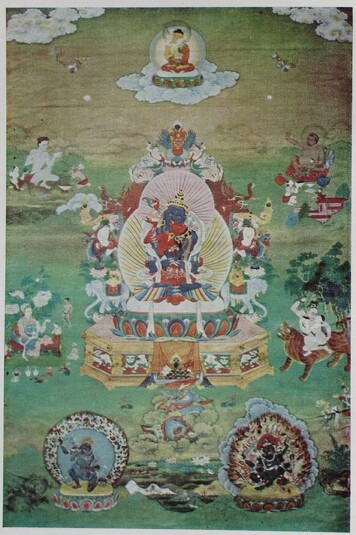
Item: Vajradhara Buddha - with the 84 Mahasiddhas
| Origin Location | Tibet |
|---|---|
| Date Range | 1700 - 1799 |
| Lineages | Karma (Kagyu) and Buddhist |
| Material | Ground Mineral Pigment on Cotton |
| Collection | Private |
Classification: Deity
Appearance: Peaceful
Gender: Male
Vajradhara and consort Bhagavani (Tibetan: dor je chang): the primordial Buddha of Tantric Buddhism and the spiritual source for the Buddhist Tantric literature along with four of the Eighty-four Mahasiddha. This is the first painting in a set of eleven paintings.
This composition is the first, center, in a set of eleven paintings depicting Vajradhara and the Eighty-four Mahasiddha according to the system of Abhayadatta Shri. The first painting contains Vajradhara and four mahasiddha, Luipa, Virupa, Indrabhuti and Dombi Heruka, along with a Buddha at the top and two deity figures at the bottom. Each subsequent painting in the set contains a bodhisattva at the top center and eight mahasiddha per composition. The ordering of the siddha follows the sequential enumeration from the text called The History of the Eighty-four Mahasiddha (Tibetan: grub thob brgyad bcu tsa bzhi'i lo rgyus) by the Indian scholar Abhayadatta Shri (12th century. Full Tibetan text in PDF format: Part 1, Part 2, Part 3).
Seated at the center of the composition is blue Vajradhara with his red consort, Bhagavani. He holds a vajra and bell crossed at the heart and the consort holds a curved knife and skullcup. Richly attired and adorned with jewels and silks they sit in vajra posture atop a lotus and lion supported throne. Behind the couple is an elaborate throne back (Sanskrit: torana) decorated with elephants, snow lions, makara sea creatures and a red garuda bird at the peak.
At the top center is a Buddha figure embracing a consort and performing the gesture of teaching with the two hands at the heart. Seated on a moon disc and multi-coloured lotus throne they gently rest atop pillows of green and blue cloud floating in the sky.
At the middle left is Luipa, semi-naked, pale, with matted hair typical of a yogi, seated on a deerskin in a relaxed posture. He is eating the discarded entrails of predatory fish, abandoning societies notions of what is wholesome and unwholesome, acceptable and unacceptable. In front is a large gutted fish and at the sides are two figures, a male on the right offering a fish and a female on the left offering up a golden vase of spiritual attainments to Luipa.
Seated below is King Lilapa, in a relaxed posture atop a regal throne, richly attired with sumptuous robes and wearing a crown. Six court attendants perform various tasks, a minister, treasurer, musicians, and servants. A yogi figure stands in front.
At the middle right is the Lord of Yoga, Virupa, 'Ugly One.' Dark in colour and semi-naked, he sits in a relaxed posture with the right arm raised and the hand in a wrathful gesture aimed at the sun in the sky above. The left hand holds a black deer horn used as a drinking cup. A large blue jar of alcohol sits in front and a barmaid offers up a large cup of the libation. An Indian king below offers payment for the alcohol recalling an episode from the life-story of Virupa.
Below that is Dombi Heruka, embracing his naked consort and riding on the back of a pregnant tigress. A hood of six snakes adorns his head and he holds in the right hand upraised a seventh snake as a whip. On the grass below, five figures pay homage with offerings, and ask forgiveness. This miniature scene recalls an event in the life-story of Dombi Heruka.
At the bottom left is the meditational deity Blue Achala with the consort Mamaki, in the form known as Maha Chandaroshana. He is in a kneeling posture and with the two hands the right is upraised holding a sword and the left holds a lasso. A circle of multi-coloured flames surrounds the couple as they kneel on a sun disc and lotus seat.
At the right side is the fiercely wrathful protector, the Great Black One, Mahakala, in his form known as Chaturbhuja (four-armed). He has one face and four arms holding a curved knife and skullcup at the heart in the first pair and an upraised sword and trident in the second pair. The consort is light blue in colour and holds a double-sided drum and a skullcup. Seated in a posture with the legs splayed atop two human corpses, above a sun disc and lotus seat, they are completely surrounded by the brightly burning flames of pristine awareness.
The two wrathful figures, Achala and Chaturbhuja Mahakala, have long been associated with the Eighty-four Mahasiddha in Tibetan ritual, initiation and meditation texts. (See painting 99215 for a comparison of the composition).
Numbered List:
Top center: Unidentified Buddha
Center: Vajradhara and Bhagavani
1. Luipa (top left)
2. Virupa (top right)
3. Lilapa (middle left)
4. Dombhi Heruka (middle right)
Bottom left: Achala
Bottom right: Chaturbhuja Mahakala
Jeff Watt 1-2006
Exhibition: Tibet House Museum 1st Exhibition
Thematic Sets
Buddhist Deity: Vajradhara (with Three Eyes)
Painting Style: Palpung Monastery (Masterworks)
Indian Adept: Virupa (Holding a Horn)
Indian Adept: Virupa (Jonang Iconography Style)
Buddhist Deity: Vajradhara, 金刚总持, རྡོ་རྗེ་འཆང། (Painting Masterworks)
Buddhist Deity: Vajradhara & Eighty-four Mahasiddhas
Painting Set: Indian Adepts (84) - Palpung Composition
Buddhist Deity: Vajradhara & Mahasiddhas (Sets of Paintings)
Buddhist Deity: Vajradhara with Consort (Painting)


